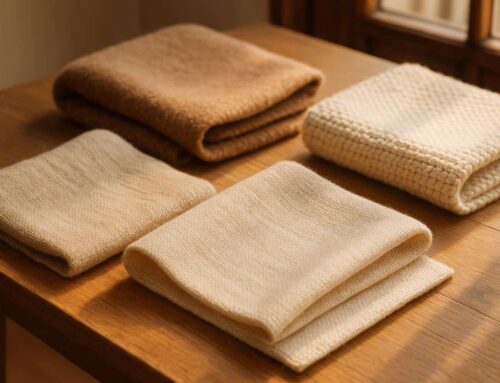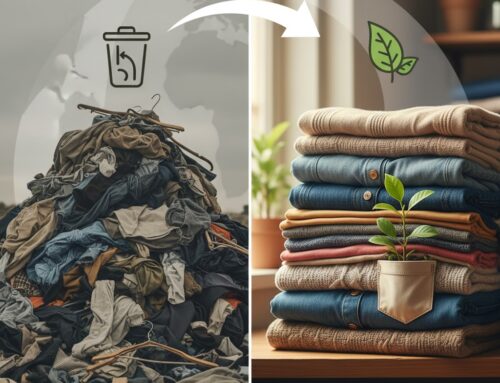Fast fashion is a major source of textile waste, but thrift shopping offers a simple way to help reduce this problem. By buying secondhand, you extend the life of clothing, cut down on waste, and lower demand for new production.
Here’s why thrift shopping matters:
- Reduces landfill waste: Millions of pounds of clothing are saved from landfills through resale and reuse.
- Conserves resources: Producing new clothes uses water, energy, and raw materials. Thrifted items skip this process.
- Supports communities: Thrift stores provide affordable options and fund local programs like shelters and poverty relief.
Every thrift store purchase or donation contributes to a circular system where clothing is reused instead of discarded. It’s an easy, impactful way to fight waste and rethink how we consume fashion.
How Thrift Shopping Cuts Textile Waste
Thrift stores play a crucial role in reducing textile waste by intercepting millions of pounds of clothing that might otherwise end up in landfills. They transform these items into resources that benefit communities while giving garments a second chance at life.
Thrift Stores Keep Clothing Out of Landfills
Thrift stores act as a bridge between discarded clothing and new owners, extending the life of garments through resale and reuse. For instance, Goodwill alone receives nearly 6 billion pounds of donations every year.
When you donate clothes, these items are carefully sorted by trained staff. Garments in good condition are cleaned, priced, and placed on the sales floor, ensuring they remain in use rather than being discarded.
Even items that don’t sell aren’t wasted. Many are sent to salvage markets where they’re repurposed into industrial products like cleaning wipes, carpeting, or insulation materials. Some are even exported to other countries for resale, further extending their usefulness.
This process not only keeps clothing out of landfills but also contributes to environmental benefits by reducing waste and maximizing the lifespan of textiles.
The Environmental Benefits of Thrift Shopping
Buying secondhand clothing has a positive impact on the environment. When you choose pre-owned items, you reduce the demand for new clothing production. This helps conserve natural resources like water and energy, lowers carbon emissions from manufacturing, and minimizes the waste generated by producing new textiles.
The savings can be dramatic. For example, producing a single cotton t-shirt requires about 2,700 liters of water. By opting for thrifted clothing, shoppers help conserve these resources and avoid the energy-intensive processes involved in making new garments.
Additionally, thrift shopping reduces the carbon footprint tied to shipping new clothing from overseas factories. Since secondhand items are typically available locally, they’re ready for immediate use without the need for long-distance transportation.
Donations: A Key to Reducing Waste
Clothing donations are a cornerstone of a sustainable, circular system. They enable reuse, repair, and recycling, ensuring items stay in circulation rather than contributing to landfill waste. By donating quality items, you help stock thrift stores and support this eco-friendly cycle.
Take, for example, a dress donated to City Thrift in Kansas City. That single garment could serve multiple owners over its lifetime, with each person enjoying months or even years of wear. Clean, undamaged donations are especially impactful, as they’re more likely to find new homes quickly and remain in use for longer.
Every donation and purchase from a thrift store contributes to a system that values sustainability, reduces waste, and supports communities.
How Thrift Shopping Fights Fast Fashion
Thrift shopping takes aim at the fast fashion industry by extending the life of clothing and reducing the need for constant production. It’s a simple yet impactful way to challenge the wasteful cycle that fast fashion thrives on.
Lowering Demand for New Clothes
Every thrifted piece of clothing represents one less item that needs to be manufactured. When you buy a pre-owned sweater from a place like City Thrift in Kansas City, for example, you’re giving that garment a second, third, or even fourth life instead of letting it end up in a landfill.
This reuse does more than just keep clothes out of the trash. It also cuts down on the demand for resource-heavy production processes, saving raw materials, water, and energy. By keeping garments in circulation longer, thrift shopping supports a circular economy where the environmental burden of manufacturing is significantly reduced.
Building Better Shopping Habits
Thrift shopping naturally shifts the way people think about buying clothes. Unlike fast fashion stores, which thrive on impulse purchases fueled by constant sales and ever-changing trends, thrift stores offer a slower, more intentional shopping experience. You might not find the exact item, size, or color you’re after, but that’s part of the charm. It encourages you to slow down and focus on what you truly need.
This approach helps shoppers embrace the principles of slow fashion: valuing quality over quantity, appreciating unique finds, and making thoughtful decisions. These habits not only reduce waste but also lead to tangible carbon savings by cutting back on unnecessary consumption.
Measuring the Carbon Impact
The environmental benefits of buying secondhand are clear and measurable. Thrifted items don’t require new manufacturing or transportation, which significantly lowers the carbon emissions tied to producing new clothing. For instance, opting for a thrifted jacket eliminates the emissions associated with its production and shipping.
There’s also a deeper impact. By reducing the demand for fast fashion, thrift shoppers help ease the pressure on factories to churn out clothing quickly and cheaply. This, in turn, challenges the exploitative labor practices often tied to mass production. Each secondhand purchase becomes a small but meaningful step toward a more responsible and sustainable fashion industry.
How Thrift Stores Help Communities and the Environment
Thrift stores make a meaningful impact by tackling environmental waste and supporting community needs. They combine waste reduction with initiatives that uplift individuals and families, creating benefits that ripple through both society and the planet.
Affordable Items and Community Support
Thrift stores provide affordable, quality goods that help families stretch their budgets. For low-income households, this can make a big difference in managing everyday expenses. Beyond affordability, many thrift stores go a step further by offering direct aid – like free shopping opportunities for individuals facing homelessness or fleeing domestic violence. These efforts ensure that essential items are accessible to those who need them most.
What’s more, the money generated from thrift store sales often funds local programs aimed at addressing critical issues like homelessness and poverty. By shopping at these stores, customers directly support initiatives that strengthen their communities. This dual purpose of affordability and reinvestment aligns with eco-friendly practices that extend the life of donated items.
Green Practices at Thrift Stores
At City Thrift, unsold items don’t go to waste. Instead, they’re repurposed through partnerships with local recycling programs. This approach ensures that every donation contributes to reducing environmental impact, giving items multiple chances to serve a purpose.
City Thrift‘s Work in Kansas City
City Thrift stands out in Kansas City for its dedication to both community support and sustainability. Every dollar earned at its stores goes to City Union Mission, an organization providing meals, shelter, and support services for people experiencing homelessness and poverty in the area. Each purchase directly funds programs that assist those in need.
Donations to City Thrift include clothing, furniture, toys, and household goods, all of which help sustain its mission. The store also offers opportunities for community involvement. Volunteers can assist with sorting donations or running store operations, while paid positions provide stable jobs with benefits. By reinvesting proceeds into local programs and embracing a circular economy model, City Thrift exemplifies how sustainable fashion can drive positive change for both people and the planet.
Fast Fashion vs. Circular Fashion: Side-by-Side Comparison
Let’s dive into how fast fashion and circular fashion stack up against each other. These two approaches couldn’t be more different when it comes to production, consumption, and waste management. The result? They lead to vastly different environmental and social outcomes.
Production Models and Impact Comparison
Fast fashion thrives on speed and low costs. Brands churn out new styles constantly, aiming to keep up with ever-changing trends. This often involves using new materials and energy-heavy processes. On the flip side, circular fashion is all about making clothes last longer. It emphasizes durability, repair, reuse, and recycling – encouraging people to buy less and use items longer.
Here’s how the two models differ:
- Fast fashion pushes out new collections frequently to match trends, while circular fashion leans toward timeless or seasonal designs that stay relevant longer.
- Fast fashion consumes a lot of resources and generates significant waste. Circular fashion, however, eases environmental strain by focusing on reusing and recycling materials.
- Economically, fast fashion may seem cheaper upfront, but its hidden costs – like environmental damage and social consequences – are steep. Circular fashion, meanwhile, invests in durability and material recovery to retain value over time.
This contrast highlights why thrift shopping plays a key role in supporting circular fashion. Every thrifted item extends the life of a garment and reduces the demand for new production, directly challenging the fast fashion cycle.
Why Thrift Shopping Matters for the Future
As we’ve explored, thrift shopping isn’t just a trend – it’s a practical way to address the environmental challenges caused by fast fashion. Every time you choose second-hand over new, you’re helping to reduce waste, conserve resources, and support your local community.
Key Points to Remember
When you shop second-hand, you actively contribute to a circular economy that values reuse over waste. This means fewer resources like water and energy are spent on producing new clothing, and carbon emissions from manufacturing are significantly reduced.
Thrift shopping also strengthens communities. It provides affordable options for families, supports charitable programs, and creates volunteer opportunities that bring people together. It’s a way to shop with purpose, knowing your choices make a real difference.
On a personal level, thrifting encourages smarter consumption – buying only what you need, appreciating quality, and embracing individuality in your style. With 69% of the global population believing sustainability starts with individual actions, thrift shopping becomes a simple yet powerful way to contribute to a healthier planet.
Take Action Today
- Donate your unused items: Instead of tossing them out, give your clothes and household goods a second life by donating them to local thrift stores.
- Shop second-hand first: Before buying new, check out thrift shops for affordable, sustainable options that support good causes.
- Get involved: If you’re in Kansas City, visit City Thrift to donate, shop, or volunteer. Your contributions directly support City Union Mission’s efforts to combat homelessness and poverty.
- Spread the word: Share your thrift finds and the benefits of second-hand shopping with friends and family. Encourage others to join the movement, and even learn basic repair or upcycling skills to extend the life of your items.
The shift away from fast fashion begins with small, meaningful actions. Every thrift store purchase, donation, and conversation about sustainable shopping helps reshape the future of fashion. Together, we can reduce textile waste and create a more sustainable world – one choice at a time.
FAQs
How does thrift shopping help reduce waste and environmental impact in the fashion industry?
Thrift shopping is a great way to cut down on waste while giving clothing and other textiles a second life. When you buy second-hand, you’re reducing the need for new garments to be made. This helps curb the demand for resource-heavy manufacturing processes and cuts back on greenhouse gas emissions.
It also keeps perfectly usable items from ending up in landfills, shrinking textile waste, and encouraging a more circular way of consuming. Plus, shopping at places like City Thrift doesn’t just help the planet – it also supports local communities through various charitable programs and initiatives.
What happens to donated clothing that doesn’t sell at thrift stores?
When thrift stores can’t sell donated clothing, those items often take on new lives in different ways. Many are passed along to charities or organizations that distribute them to people in need. Some are shipped overseas to assist communities around the world. Others are repurposed into materials like insulation, industrial rags, or even new textiles. Sadly, some unsold pieces may still end up in landfills. By choosing to donate to thrift stores like City Thrift, you give clothing a second chance, help cut down on textile waste, and contribute to both environmental and community well-being.
How does thrift shopping benefit local communities and support charitable causes?
Thrift shopping plays a vital role in supporting local communities by channeling funds into essential services like housing assistance, job training, and outreach programs. These initiatives directly benefit individuals and families who need a helping hand. Many thrift stores are also tied to nonprofit organizations, using their earnings to bolster social programs and enhance community resources.
Beyond financial support, thrift shopping fosters a sense of community. It encourages people to donate items they no longer need and volunteer their time, creating a shared effort toward meaningful causes. On top of that, it promotes sustainability by giving items a second life, reducing waste, and making a positive impact on the environment.






